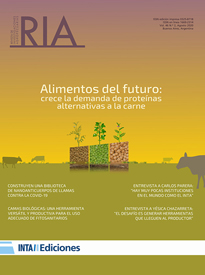Ver ítem
- xmlui.general.dspace_homeCentros Regionales y EEAsCentro Regional Santa FeEEA RafaelaArtículos científicosxmlui.ArtifactBrowser.ItemViewer.trail
- Inicio
- Centros Regionales y EEAs
- Centro Regional Santa Fe
- EEA Rafaela
- Artículos científicos
- Ver ítem
Evaluación de la calidad de subproductos de la soja
Resumen
Los subproductos provenientes de la agroindustria suelen presentar una alta variabilidad en su calidad nutricional. Esto resulta problemático al momento de utilizarlos en dietas destinadas a producción animal. En el presente trabajo se analizó mediante ensayos químicos, in sacco y encuestas el perfil nutricional y la variabilidad de expellers y harinas de soja provenientes de la región de Rafaela, Santa Fe. A partir de las muestras se observó que la
[ver mas...]
Los subproductos provenientes de la agroindustria suelen presentar una alta variabilidad en su calidad nutricional. Esto resulta problemático al momento de utilizarlos en dietas destinadas a producción animal. En el presente trabajo se analizó mediante ensayos químicos, in sacco y encuestas el perfil nutricional y la variabilidad de expellers y harinas de soja provenientes de la región de Rafaela, Santa Fe. A partir de las muestras se observó que la variabilidad en los indicadores de la calidad nutricional de estos subproductos, tales como contenido de proteína bruta (PB), extracto etéreo (EE) y degradabilidad, no fue diferente a la reportada por la bibliografía nacional. Además, dicha variabilidad pudo ser explicada por factores tales como los contenidos de EE y fibra cruda (FC), y estuvo asociada con la solubilidad de la proteína en hidróxido de potasio (PB-KOH). En correspondencia con esto, los expellers presentaron menor degradabilidad que las harinas. Entre los factores del procesamiento industrial que modificaron la variabilidad del expeller se encontró que la limpieza del grano previo a la extracción del aceite aumentó el contenido de EE del poroto y disminuyó el del expeller, incrementando un 22% la eficiencia de extracción. El tratamiento térmico modificó las fracciones de degradabilidad a través de la disminución de la fracción a (inmediatamente soluble) y el aumento de la fracción b (potencialmente degradable). Además de limpiar el grano, este trabajo indica que para disminuir la variabilidad de estos subproductos deberían implementarse controles de calidad sencillos y confiables como PB-KOH. Esto permitiría generar planes de protocolización y reducir la variabilidad del EE en estos subproductos.
[Cerrar]
By-products from agribusiness tend to have high variability in nutritional quality. This is problematic when used in diets intended for animal production. In the present work, the nutritional profile and variability of expellers and soy flour from the Rafaela, Santa Fe region were analyzed through chemical tests, in sacco and surveys. From the samples it was observed that the variability in the indicators of nutritional quality of these by-products, such
[ver mas...]
By-products from agribusiness tend to have high variability in nutritional quality. This is problematic when used in diets intended for animal production. In the present work, the nutritional profile and variability of expellers and soy flour from the Rafaela, Santa Fe region were analyzed through chemical tests, in sacco and surveys. From the samples it was observed that the variability in the indicators of nutritional quality of these by-products, such as crude protein content (PB), ethereal extract (EE) and degradability, was not different from that reported by the national literature. In addition, this variability could be explained by factors such as the contents of EE and crude fiber (FC), and was associated with the solubility of the protein in potassium hydroxide (PB-KOH). In correspondence with this, the expellers presented less degradability than the flours. Among the factors of industrial processing that modified the variability of the expeller, it was found that cleaning the grain prior to oil extraction increased the EE content of the bean and decreased that of the expeller, increasing the extraction efficiency by 22%. The heat treatment modified the degradability fractions through the decrease in fraction a (immediately soluble) and the increase in fraction b (potentially degradable). In addition to cleaning the grain, this work indicates that to reduce the variability of these by-products, simple and reliable quality controls such as PB-KOH should be implemented. This would allow generating protocolization plans and reducing EE variability in these by-products.
[Cerrar]

Autor
Seijas Noya, Ignacio José;
Jaurena, Gustavo;
Wawrzkiewicz, Marisa;
Gaggiotti, Monica Del Carmen;
Romero, Luis Alberto;
Mendez, Jose Maria;
Fuente
RIA 46 (2) : 258-266 (Agosto 2020)
Fecha
2020-08
Editorial
Ediciones INTA
ISSN
0325-8718
1669-2314
1669-2314
Formato
pdf
Tipo de documento
artículo
Palabras Claves
Derechos de acceso
Abierto
 Excepto donde se diga explicitamente, este item se publica bajo la siguiente descripción: Creative Commons Attribution-NonCommercial-ShareAlike 2.5 Unported (CC BY-NC-SA 2.5)
Excepto donde se diga explicitamente, este item se publica bajo la siguiente descripción: Creative Commons Attribution-NonCommercial-ShareAlike 2.5 Unported (CC BY-NC-SA 2.5)


